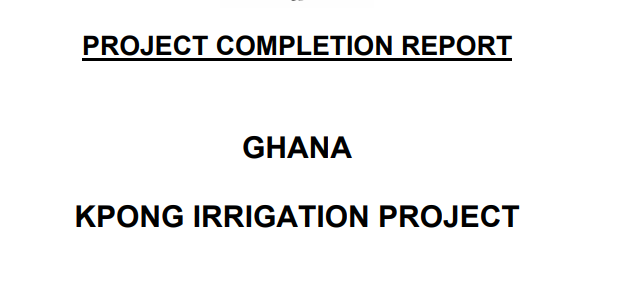The present intervention concerns the Kpong Irrigation Project (KIP). This project is to support Ghana’s economic recovery programme by contributing to the achievement of food security and self-sufficiency and improved living standards especially of the smallholder rice farmers in the project area. This should help the net annual family incomes increasing by Cedis 300,000 ($ 858 at 1991 exchange rates) from an average of 7,000 Cedis before the project. The project comprises of the following components: a) land development, b) buildings and infrastructure, c) vehicles and equipment, d) institutional support and training, e) construction supervision, f) credit, and g) recurrent costs.
The project which cost US $36M is part of the Ghana Commercial Agricultural Project (GCAP) which has so far recorded 13,190 hectares of additional irrigable land through the rehabilitation of the Tono, Kpong Left Bank and Kpong irrigation schemes for rice and vegetables.
Kpong Irrigation Scheme
Works on the project which is located in Kassena-Nankana Municipality, Upper East Region of Ghana, consisted of the reconstruction of the retaining walls, irrigation canals, dam floor, laterals and other parts of the structure built in 1975. The spillway and the spillway of the water reservoir were also rehabilitated. The Ghanaian government obtained the funds from several funding partners, including the World Bank and the United States Agency for International Development (USAID).
The re-commissioning of the Tono Dam (4km long) will make water available for the irrigation of 2,490 hectares of rice fields and vegetable plantations in the communities of Kassena-Nankana and Builsa. An intake from the Tono multi-purpose dam will also supply the new drinking water plant in the Ghanaian city.
kpong irrigation scheme
The plant built at Tono will be capable of treating 20,500 m3 of water per day. The Ghana Water Company Limited (GWCL) will operate the future plant which will serve the towns of Navrongo, Paga, Zuarungu, Bolgatanga and surrounding communities.
“Among the immediate benefits of the project is an increase in rice yield from 4.5 to 5.5 tonnes per hectare, which has led to increased production and farm income. Some 14,264 smallholder farmers have benefited directly, creating 40,000 jobs in several value chain activities generated by the irrigation projects,” said the president.
kpong irrigation scheme 2022
This study examines management problems of WUA C1 of the Kpong Irrigation Scheme (KIS) in Ghana using the 13 evaluation indicators derived from theories of common-pool resources management proposed by Ostrom and Freeman. The evaluation shows that WUA C1 lacks the indicator of water control ability even though C1 has fine irrigation facilities that enable independent water management within WUAs. The reason is that KIS has been managed by Joint System Management (JSM) in which the KIS Office of Ghana Irrigation Development Authority operates and maintains the main canal, main drainage and main road, while WUA C1 operates and maintains the branch canal and below.
However, the KIS Office could not fully operate and maintain the irrigation facilities because of budgetary limitations. In irrigation management transfer, it is common to set JSM that allots the management of main canals to the government (or scheme management entity), and the management of lateral canals and below to WUAs. However, from the perspective of WUA organizational evaluation, it is possible that JSM harms the water control ability of WUAs.
In Ghana empirical reports indicate that farmer participation in irrigation projects is still very low, putting sustainability of such irrigation projects at risk. The study sought to determine the extent to which socio-economic and institutional factors influence the level of farmers’ participation and sustainability of the Kpong Irrigation Scheme. Using survey research design, quantitative data were collected from 200 respondents who were selected through systematic random sampling. The study found that socio-economic factors such as educational status and group size had significant influence on farmer participation while institutional factors such as water supply, benefits der

